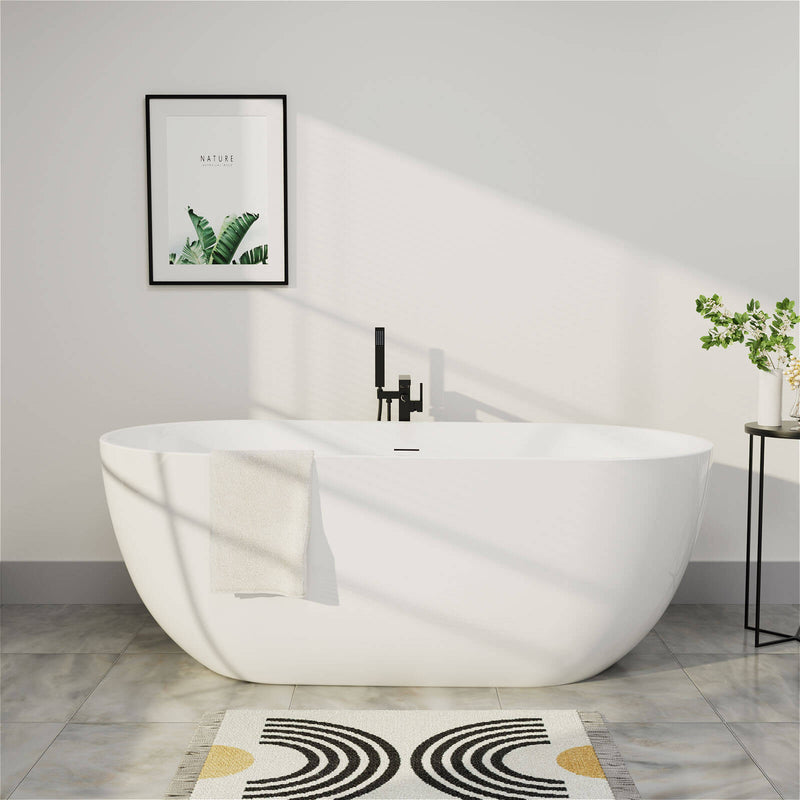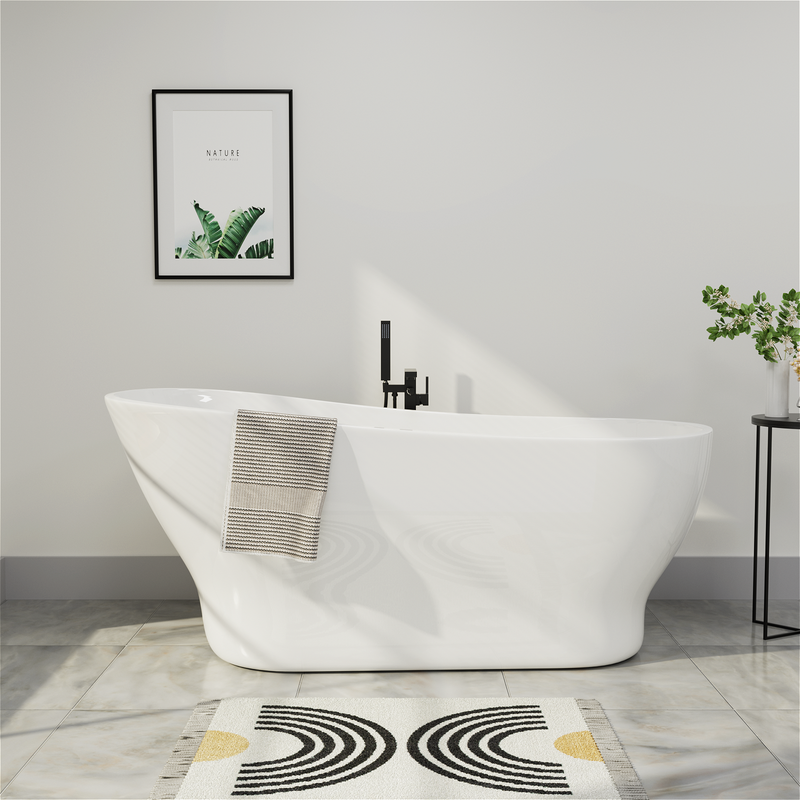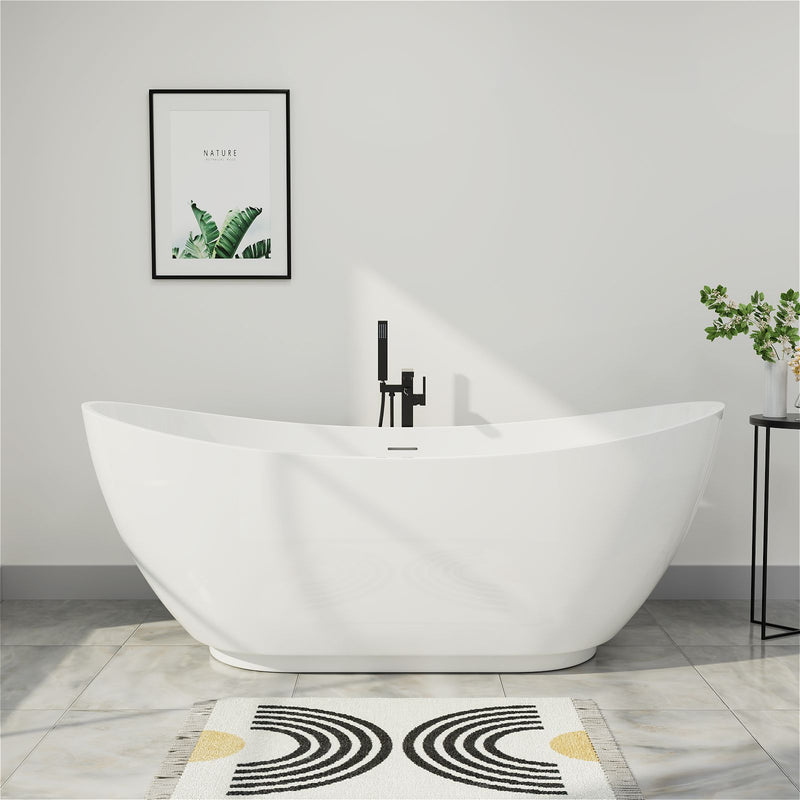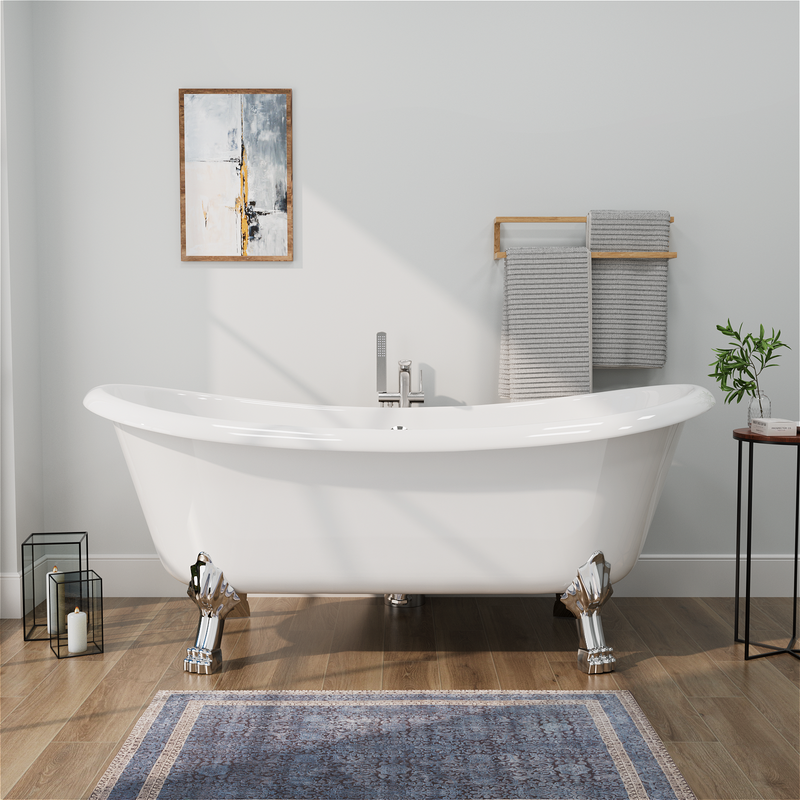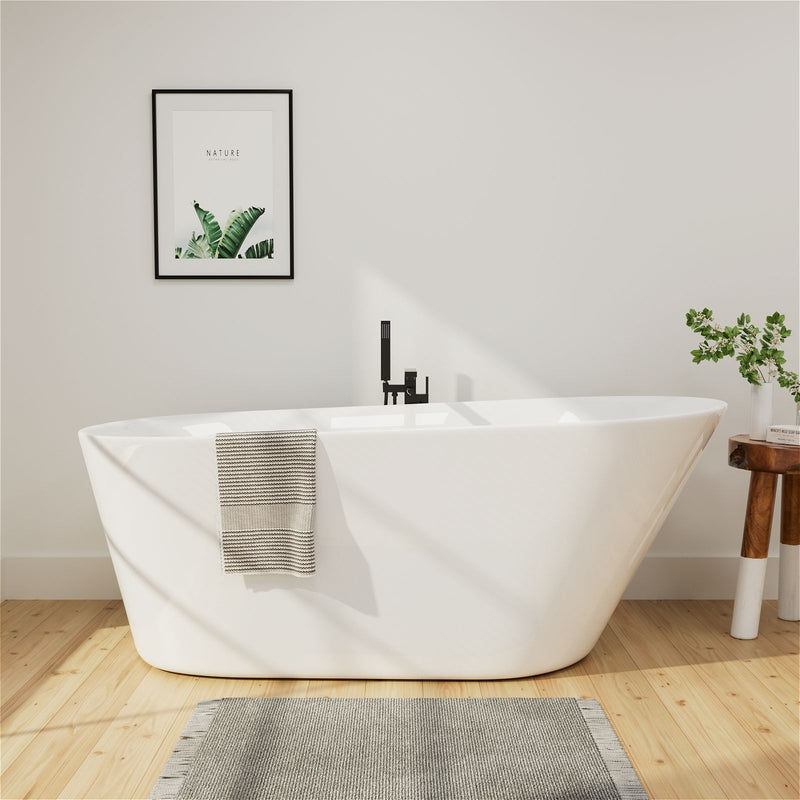What is a Japanese Soaking Tub?
A Japanese soaking tub, also known as an ofuro, is a small, deep bathtub designed to provide a relaxing bathing experience. Unlike traditional Western-style bathtubs, these tubs are designed for full-body immersion, allowing you to soak comfortably up to your chin. Typically, these tubs are round or square and made of wood, acrylic, or stone. This unique design not only provides a soothing spa experience, but also conserves water.
Compared to longer and shallower Western-style bathtubs, Japanese soaking tubs focus more on depth than length. This compact and deep design is suitable for both small and modern bathrooms, making it a popular choice for homeowners looking to optimize space. In addition, the upright sitting position in the tub helps to relax the mind and body, providing a peaceful and calming bathing experience. It's no surprise that more and more people are learning how to install a Japanese soaking tub in their homes.

History of Japanese Soaking Tubs
Today's Japanese soaking tubs have their roots in the ancient Japanese ritual of bathing, or purification. Bathing rituals are an important part of Japanese culture, a ritual of cleansing and rejuvenation, where people bathe to purify their bodies and souls.
Traditionally, bathing began with a shower, with running water being the best way to remove dirt from the skin. This is a completely natural process, without the use of soap. After the shower, the body is immersed in a traditional Japanese soaking tub (Ofuro) up to the chest. Even now, the Japanese wash their bodies before entering the tub, as they do not usually change the water in the tub between baths and need to keep the tub as clean as possible.
Bathers would step into this deep wooden container, which is filled with mineral water that reaches temperatures of up to 50 degrees Celsius, while the average temperature in Japan today is 40-42 degrees Celsius (104-108 degrees Fahrenheit). Then, just like in the spring waters of a natural onsen, they would sit and soak.
The experience is more than just cleansing. It is said to benefit the immune system, promote cardiovascular health, and help to eliminate toxins from pathogens in the body. One study found that 87.5% of Japanese people enjoy soaking in a tub, and 70% do so every day in winter.

Today, modern Japanese soaking tubs are ubiquitous in bathrooms in homes, apartments, luxury spas, and boutique hotels. It’s quickly becoming one of the latest trends in contemporary bathroom furniture, but its popularity stems from the solemnity and ritual of ancient Japan.
Advantages of Japanese Soaking Tubs
Imagine stepping into a bathtub at the end of a busy day and feeling like a warm, cozy hug. That’s the experience you get with a Japanese soaking tub, which blends tradition with luxury into a modern bathroom. Here are its benefits:
Comfort
In the West, we’re used to half-lying in the tub, with our legs stretched out and our head and shoulders resting on the back of the tub. Soaking in a Japanese soaking tub gives a whole new meaning to relaxation. Instead of lying down, you sit upright on a built-in bench. Your feet are below your waist, your back is straight, and your head and shoulders are naturally supported by your spine. It’s very comfortable—none of the pressure on your shoulders and neck that comes with lying down in a traditional bathtub.
Relaxation and Stress Relief
One of the great benefits of a Japanese soaking tub is the deep relaxation it provides. A deep soaking tub allows for complete immersion, promoting muscle relaxation and stress relief. The warm water and upright sitting position create a cozy atmosphere that’s ideal for relaxing after a busy day.
Water Efficient
Japanese soaking tubs are designed to conserve water compared to traditional Western-style tubs. Although the tub is deep, it holds relatively little water due to its compact size. This energy-efficient design not only saves water, but also reduces heating costs, making it an eco-friendly choice for any home.
Space-Saving Design for Small Bathrooms
Japanese tubs are ideal for small bathrooms due to their compact design yet deep. Unlike traditional large tubs that take up a lot of space, Japanese tubs are able to fit neatly into small spaces, helping homeowners maximize their bathroom layout. Japanese tubs are a smart choice for those who want a luxurious bathing experience without sacrificing space.

Convenience
Not only do Japanese soaking tubs fit neatly into small spaces, they are also a convenient bathroom addition for those who want to soak alone or with others.
Japanese soaking tubs are full of features that allow you to customize your bathing experience: jets, grab bars, and a wide variety of design options. And, because Japanese soaking tubs are more compact than standard bathtubs, you can easily install them anywhere you want – against a wall, in a corner, submerged, semi-submerged, or standing majestically in the center of a room.
You can also install a shower above the tub, and if you prefer, a shower screen, making the Japanese soaking tub a convenient alternative to a traditional bathtub – while also paying homage to the pre-soaking rituals of the past.
Considerations Before Installing a Japanese Soaking Tub
Before you enter the tranquil world of a Japanese soaking tub, there are several important factors to consider. Installing a Japanese soaking tub requires careful planning, ensuring that everything from space to plumbing is prepared for this unique addition. By addressing these aspects, you’ll create an environment where a deep soaking tub can truly shine, bringing comfort and elegance to your bathroom.
Space Requirements
When considering installing a Japanese soaking tub, it’s vital to first measure the bathroom dimensions to ensure that there is enough space. Japanese tubs are known for their compact and deep design, making them more suitable for smaller spaces than traditional tubs. However, the right size is essential to ensure that the tub sits comfortably and doesn’t appear crowded.
The ideal bathroom layout for a Japanese soaking tub is often focused on efficient use of space. For smaller bathrooms, placing the tub in a corner is a smart choice to allow for easy movement within the bathroom. For larger bathrooms, placing the tub in the center of the room can make the Japanese tub a focal point, enhancing the room’s aesthetics without sacrificing practicality.
Ventilation
Good ventilation is a key consideration when installing a Japanese soaking tub, as it helps prevent moisture buildup. These deep soaking tubs have an inviting warm water temperature, which can add humidity to the bathroom, which can lead to mold growth if not managed properly. Ensuring adequate air circulation can help keep the bathroom environment fresh and healthy.
Installing an efficient exhaust fan or opening windows regularly can help maintain good ventilation. Doing so can extend the life of your bathroom fixtures and protect the integrity of the materials used, especially if you have a traditional Japanese wooden tub. This will create a comfortable and safe bathing space, maximizing the relaxing benefits of your new tub.

Material and Design Choices
Choosing the right material for your Japanese soaking tub is crucial, as it will affect the tub’s appearance and longevity. Traditional Japanese wooden tubs have a warm, natural feel, perfect for adding a touch of authenticity. Acrylic tubs are lightweight and easy to maintain, and can blend in beautifully with modern bathroom tub designs. If you value durability and elegance, stone tubs are a luxurious and sturdy option, albeit with a higher price tag.
Choose a design that complements your bathroom aesthetic and ensures the tub blends harmoniously with the overall decor. Whether your style is minimalist, modern, or traditional, there is a Japanese soaking tub that will work for you. Consider factors like color, shape, and finish to ensure they blend in with your existing bathroom fixtures to create a harmonious, warm, spa-like bathroom environment.
Budget
When planning to install a Japanese soaking tub, it’s important to understand the cost range so that it fits in with your financial planning. Tubs made from materials like wood and stone are often pricier, ranging in the thousands of dollars, while acrylic tubs may be more affordable. In addition to the tub itself, consider the cost of installation, which can vary depending on the bathroom layout and plumbing adjustments required.
Balancing cost with quality is key to ensuring your investment is worth it. While it’s tempting to go for the cheapest option, focusing on long-term durability and material quality can save on future repairs and replacements. Choose the best Japanese tub that fits your budget while offering a reliable, beautiful design that will keep you happy for years to come.
How to Install a Japanese Soaking Tub
If you're ready to enjoy the relaxing experience of a Japanese soaking tub, understanding how to properly install it is the first step. This guide will walk you through the Japanese soaking tub installation process, from planning to final completion, to ensure a smooth and seamless installation.
Step 1: Plan the Installation
First, create a detailed bathroom layout to determine the best location for your Japanese tub. Accurate measurements are essential to ensure the tub fits comfortably in your space and doesn't disrupt the room's flow. Clear planning can help avoid costly mistakes later.
Next, consider consulting a contractor or exploring DIY resources to learn about the specific requirements and potential challenges of the installation process. Professionals can provide insight and guidance, especially if your bathroom requires plumbing adjustments or structural reinforcements. Whether you choose to DIY or hire a contractor, proper planning will lay the foundation for a successful Japanese soaking tub installation.

Step 2: Prepare the Bathroom
If your installation requires replacing an existing tub, the first priority is to remove it safely, make sure you have all the necessary tools, and avoid damaging the bathroom. Taking this step allows you to fully assess the space and make any necessary adjustments before installing your new Japanese soaking tub.
Next, focus on the flooring underneath the tub, as it is critical to ensure it is waterproof and durable. A waterproof floor prevents moisture-related issues that are common with deep soaking tubs because they can cause spills or leaks. Depending on your current flooring material, you may need to apply a waterproof sealant or consider upgrading the flooring to a more suitable material (such as tile or stone) that can withstand the tub's environment.
Step 3: Install Plumbing
When installing a Japanese soaking tub in your bathroom, proper plumbing is essential to ensure a smooth bathing experience. First, install the water supply and drainage pipes, making sure they meet the tub's specifications and the bathroom layout. This may require rerouting or installing new pipes to accommodate the deep soaking tub's unique design.
Also, evaluate your hot water supply to ensure it can adequately handle the needs of the new tub. Japanese soaking tubs typically require a lot of hot water, so you may need to adjust the capacity or settings of your water heater. This step is essential to maintaining a consistently pleasurable soaking experience, allowing you to bask in the warmth without interruption.
Step 4: Position the Tub
Once the plumbing is complete, it’s time to install the Japanese soaking tub in your bathroom, making sure it fits perfectly into the planned layout. Carefully move the tub into position, checking that all sides are aligned with surrounding fixtures and walls. This precise placement will not only enhance the tub’s aesthetics in your space, but also its functionality.
Once the tub is in place, it’s important to secure it properly to prevent any shifting or movement during use. Use appropriate securing methods, such as brackets or a sturdy base, to secure the tub firmly in place. This step not only enhances safety, but also ensures that your deep soaking tub will remain firmly in the center of your bathroom for years to come.
Step 5: Finishing Touches
Once the Japanese soaking tub is in place and secured, be sure to carefully seal all seams and edges to prevent leaks. Using a quality sealant will ensure that water does not seep into the tub, protecting the bathroom floor and walls from potential water damage. This step is essential to maintaining the integrity and longevity of the tub installation.
Next, focus on installing surrounding features, such as tile or backsplash, to enhance the overall look and functionality of the space. These additions not only enhance the aesthetics of the bathroom, but also protect the walls from splashing water, maintaining a clean environment. Finally, test the entire system to make sure everything is working properly—check water flow, drainage, and the overall stability of the deep soaking tub to ensure a smooth, relaxing bathing experience from day one.
Frequently Asked Questions About Japanese Soaking Tub
Q: What is the best material for a Japanese soaking bathtub?
A: Cedar, cypress, and acrylic are all good choices. Cedar and cypress are traditional materials that have a soothing aroma. Acrylic bathtubs are known for their durability, ease of maintenance, and affordability.
Q: Is wood or acrylic better for a Japanese soaking bathtub?
A: Wood has a traditional beauty and a calming aroma, but acrylic is lower maintenance and more affordable. Whatever you choose, choose the material that best fits your budget, aesthetic, and maintenance needs.
Q: Are Japanese soaking tubs comfortable?
A: These tubs are designed with comfort in mind and are deep. The material and shape of Japanese soaking tubs enhance comfort. For example, wooden bathtubs give a warm and natural feeling of embrace, which enhances the overall pleasant bathing experience.
Round bathtubs feature rounded edges for extra comfort, ensuring a soothing and enjoyable soaking experience. In addition, Japanese soaking tubs are available in a variety of sizes and shapes, allowing you to choose the best bathtub based on your comfort preferences.
Q: Why are Japanese soaking bathtubs so deep?
A: The carefully designed depth stems from the cultural values of focusing on relaxation, viewing bathing as a ritual rather than a simple task. This depth allows for full body immersion, which enhances the vitality of bathing. The careful design also allows for flexibility to accommodate a variety of bathing postures.
Q: Can Japanese soaking bathtubs accommodate two people?
A: These bathtubs vary in size. While some larger bathtubs can accommodate two people, not all Japanese soaking tubs are suitable for this purpose. Larger bathtubs may provide a unique intimate experience, allowing two people to enjoy the warmth together. However, some soaking tubs are more focused on personal relaxation rather than shared use. Therefore, you must explore different sizes to find the bathtub that best suits your bathing needs.
Q: What are the standard dimensions of Japanese soaking bathtubs?
A: Japanese bathtubs are generally smaller and deeper than standard bathtubs. Typical sizes range from 36 to 48 inches in diameter and 24 to 30 inches deep, which can accommodate full-body immersion.
Q: How to care for a Japanese wooden bathtub?
A: Always rinse the tub thoroughly and dry it completely after each use. Do not use abrasive or corrosive cleaners. Always oil it frequently to prevent cracking and extend the life of the wood.
Q: Are Japanese bathtubs easy to install?
A: Japanese bathtubs require special planning considerations for plumbing, drainage, and load-bearing. We strongly recommend having a professional installer to ensure a safe and secure installation.

